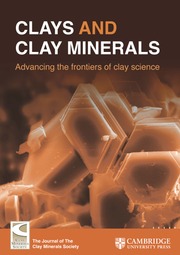Article contents
Crystallographic Controls on the Alteration of Microcline Perthites from the Spruce Pine District, North Carolina
Published online by Cambridge University Press: 28 February 2024
Abstract
Altered perthites from a weathered pegmatite in the Spruce Pine District, North Carolina, were characterized by electron microprobe as a K-rich microcline host with lesser Na-rich plagioclase having a lamellar morphology. Light-optical and transmission electron microscopy (TEM) show microtextural elements such as phase boundaries, holes and microfractures that could serve as potential nucleation sites for alteration to clay minerals.
The host microcline contains albite and pericline twinning textures that vary in character; the amount of each twinning type and/or the size of twin individuals changes on a μm scale. Plagioclase ranges from large lamellar vein and film albite (visible in the light microscope) to cryptoperthite whose size ranges from μm to perhaps 100 Å. The smallest-scale albite appears to be a late-stage phase of exsolution in which lamellae have nucleated heterogeneously on albite-twin composition planes in the microcline.
Alteration is concentrated in vein and film albite, especially along grain boundaries with microcline. Powder X-ray diffraction (XRD) patterns of intensely altered pegmatite show halloysite. Holes, microfractures, vein albite/host microcline boundaries and microcline/halloysite boundaries trend parallel to the traces of (010) and {110}, suggesting that these directions are pathways along which fluids migrate. Cleavage and microfractures occur along, and holes are bounded by, these directions. Holes are associated with dislocations and the latter are observed at feldspar/clay boundaries. Twin domains and cryptoperthitic albite are less susceptible to alteration than coarse lamellar albite and regions containing negative crystals and microfractures. However, microtextures in some areas containing halloysite suggest that once fluids penetrate the crystal, alteration may proceed preferentially in more strongly twinned regions.
Keywords
Information
- Type
- Research Article
- Information
- Copyright
- Copyright © 1997, The Clay Minerals Society
References
- 4
- Cited by

